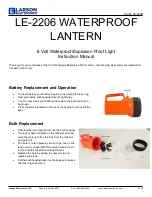
4
1
FAULTY OPERATION AND ITS POSSIBLE DIAGNOSIS
LED indicator does not light up
AC power failure or the battery not connected or damaged.
The luminaire does not operate in emergency mode the required time for a selected model
It is possible that the battery requires a full charge cycle (48h). If after 48 hours of charging the luminaire still does
not keep a predefined autonomy, it is possible that the battery is run-down or damaged due to possible incorrect
formatting and needs to be replaced.
RECOMMENDED PERIODICAL MAINTENANCE
The luminaire should be tested on regular basis in accordance with valid laws and regulations. The results of the
tests should be recorded and stored for the use of a fire safety inspector.
One time daily
It is suggested to check visually if the LED indicator in the luminaire lights up in green.
One time each month
It is necessary to perform a function test by disconnecting the AC power supply and checking whether the
luminaire is operating in emergency mode - the green LED indicator should turn off, and LEDs light up.
One time each year
In order to make an autonomy test, disconnect the AC power supply and test if the luminaire operates in
emergency mode for a specified time. If the autonomy time of emergency operation is not sufficient, the battery
needs to be fully recharged and the test is to be carried out again. If the result of the test continues to be negative,
the battery needs to be replaced.
CAUTION!
All damage that might occur as a result of the device being used not in accordance to this instruction will result in
loss of guarantee.
Used or damaged lamps including batteries, are subject to be recycled. They should be delivered to the point of
collection of electrical and battery waste or to the manufacturer.
Handling of obsolete equipment
Pursuant to the Act of 29 July 2005 on
waste
electrical
and
electronic
equipment and the Act of 24 April 2009
on batteries and accumulators, the
presented device, after use, due to
hazardous substances contained in it, is
subject to collection of waste electrical
and electronic equipment. Detailed
information on WEEE collection can be
obtained from municipal authorities.
Intelight Sp. z o.o.
8, Rydygiera str.
01 -793 Warsaw, Poland
KTM 97145 - Instruction ORION LED, EN, ver.20170302
ORION LED EMERGENCY LUMINAIRE
Installation and maintenance instructions
ORION LED 4W ORION LED 7W
OV
TECHNICAL SPECIFICATIONS:
Light source *:
(replaceability: 4W – replaceable; 7W – non-replaceable)
Version 4W: 10 x LED ; Version 7W: 41 x LED
Operating modes *:
SA - mains and emergency operation (M) or
A - emergency operation (NM)
Test versions *:
MT – manual test or
AT – auto test
Emergency autonomy *:
1 hour or 3 hours
Battery (replaceable) *:
Version 4W: Ni - Mh 1800 mAh / 3.6 V or
Ni - Cd 4500 mAh / 2.4V
Ni - Cd 1800 mAh / 3.6V
Version 7W: Ni-Cd 1500 mAh / 3.6V
Battery charging duration:
24h
Power supply:
220-240V AC 50Hz
Enclosure IP rating:
IP65
*- depending on model
INTRODUCTION
1.
The lamp should be installed when power supply is off. Safety rules, construction and electrical installation
standards should be followed all the time.
2.
The luminaire should not be powered with circuits connected to inductive power-receiving devices at the
same time. This type of solution may cause damage to the electronic module of the luminaire.
3.
The luminaire should be used indoors.
INSTALLATION
1.
Before installation one has to make sure that the luminaire will be connected to 220-240VAC power supply by
the use of minimum a 1,5mm2 wire.
2.
Open the luminaire by unscrewing two screws on its ends. Remove the cover.
3.
Open the reflector plate with LED light source either by unscrewing two screws at indicated points (for Orion
LED) or releasing two plastic locks (Orion LED 7W). Leave it on hinges.
4.
Cut out an opening in the body for power supply wires. When making openings in the body, bear in mind the
IP rating of the body and use appropriate sealing afterwards. It is necessary to use either grommets or cable
glands to maintain IP65 protection level.
5.
Install the body of the luminaire on the wall or ceiling, making the information label visible for people who will
carry out testing in future.




















